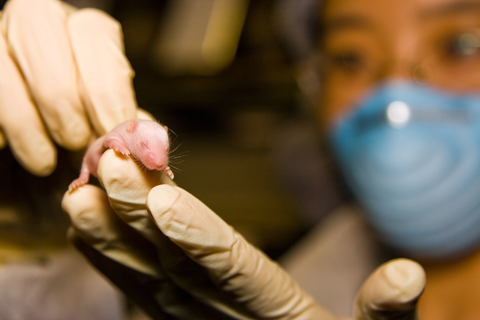Tiny robots crawl through mouse’s stomach to heal ulcers

New Scientist has reported that tiny robotic drug deliveries could soon be treating diseases inside the human body. For the first time, micromotors, autonomous vehicles the width of a human hair, have cured bacterial infections in the stomachs of mice, using bubbles to power the transport of antibiotics.
Joseph Wang at the University of California San Diego, who led the research with Liangfang Zhang, said “The movement itself improves the retention of antibiotics on the stomach lining where the bacteria are concentrated.”
In mice with bacterial stomach infections, the team used the micromotors to administer a dose of antibiotics daily for five days. At the end of the treatment, they found their approach was more effective than regular doses of medicine.
The tiny vehicles consist of a spherical magnesium core coated with several different layers that offer protection, treatment, and the ability to stick to stomach walls. After they are swallowed, the magnesium cores react with gastric acid to produce a stream of hydrogen bubbles that propel the motors around. This process briefly reduces acidity in the stomach. The antibiotic layer of the micromotor is sensitive to the surrounding acidity, and when this is lowered, the antibiotics are released.
Without this reduction, antibiotics and protein-based pharmaceuticals can be destroyed before they do any good. This mechanism means that drugs normally used to treat bacterial infections, such as ulcers, normally have to be taken alongside proton pump inhibitors that suppress gastric acid production. Long-term use of proton pump inhibitors can lead to some nasty side effects including headaches, diarrhoea, fatigue and even anxiety or depression. So being able to use tiny vehicles instead is a big step forward.
After twenty four hours, the stomach acid of the mice returned to normal levels, and as the micromotors are mostly made of biodegradable materials, they were dissolved by the stomach, leaving no harmful residues.
Thomas Mallouk at Pennsylvania State University said “It’s a really nifty and impressive application. Micromotors are still new, but their impact will be big.”
Samuel Sanchez at Max Planck Institute for Intelligent Systems said the new work is “pushing the field of micro-motors forward” and shows the benefits of using micromotors over traditional approaches.
The next steps are to look at a larger animal study, followed by eventual trials in humans. Joseph Wang said “There is still a long way to go, but we are on a fantastic voyage.”








